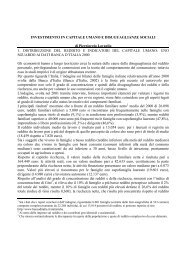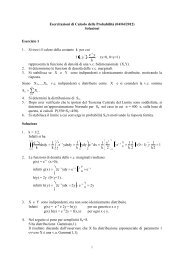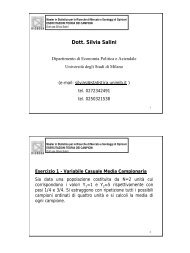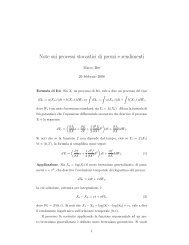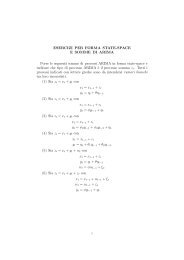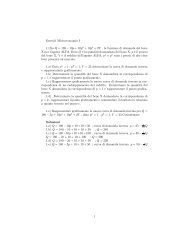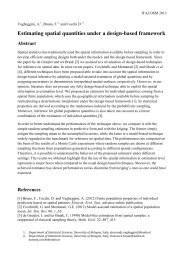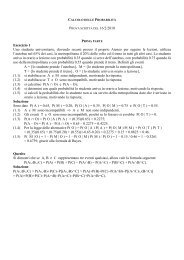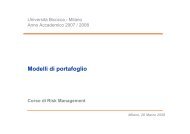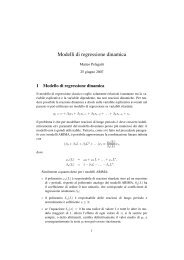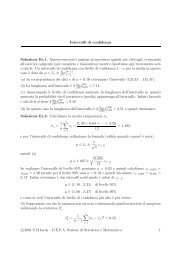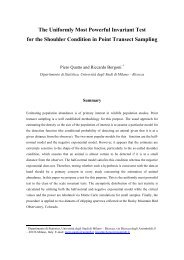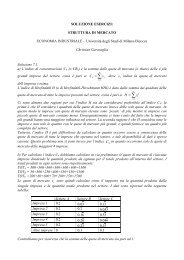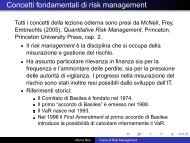Econometria S - Scienze Statistiche - Università degli Studi di ...
Econometria S - Scienze Statistiche - Università degli Studi di ...
Econometria S - Scienze Statistiche - Università degli Studi di ...
You also want an ePaper? Increase the reach of your titles
YUMPU automatically turns print PDFs into web optimized ePapers that Google loves.
Università <strong>degli</strong> <strong>Stu<strong>di</strong></strong> <strong>di</strong> Milano-Bicocca<br />
Facoltà <strong>di</strong> <strong>Scienze</strong> <strong>Statistiche</strong><br />
Corso <strong>di</strong> laurea specialistica in <strong>Scienze</strong> <strong>Statistiche</strong> ed Economiche<br />
Anno Accademico 2005/2006<br />
<strong>Econometria</strong> S<br />
(prof. Matteo Manera)<br />
Esame del 17 Luglio 2006<br />
Avete due ore per rispondere a tutte le domande riportate qui <strong>di</strong> seguito. Le domande all’interno<br />
del medesimo gruppo hanno lo stesso valore.<br />
Gruppo 1 (60 punti)<br />
1) Sia dato il seguente modello <strong>di</strong> regressione lineare:<br />
K variabili esplicative osservate. La variabile<br />
se<br />
y ≤ 0 ; y = 2 se<br />
*<br />
i<br />
i<br />
*<br />
0 yi<br />
< ≤ c ; y = 3 se<br />
i<br />
*<br />
yi<br />
*<br />
i<br />
y = x β + ε , i=1,…,N. Il vettore x i contiene<br />
*<br />
i i i<br />
y non è osservabile. La variabile osservabile è y = 1<br />
> c . 1.1) Di che tipo <strong>di</strong> modello si tratta 1.2) Scrivete<br />
la funzione <strong>di</strong> verosimiglianza per il modello in questione. 1.3) Ipotizzate che il coefficiente β 2 sia<br />
negativo. Quale sarà l’effetto <strong>di</strong> un aumento <strong>di</strong> x i2 su Prob(y i =1), Prob(y i =2) e Prob(y i =3)<br />
2) Sia dato il seguente Linear Probability Model: yi = xiβ + εi<br />
, i=1,…,N, dove il vettore x i contiene<br />
K variabili esplicative osservate, mentre la variabile y<br />
i<br />
è una dummy binaria (0,1); i termini <strong>di</strong><br />
errore ε i sono <strong>di</strong>stribuiti come una Normale con me<strong>di</strong>a nulla e varianza σ 2 . 2.1) Spiegate perché tale<br />
modello non assicura che la probabilità stimata sia compresa tra 0 e 1. 2.2) Dimostrate che i termini<br />
<strong>di</strong> errore ei sono eteroschedastici. 2.3) Ipotizzate che la variabile x i3 sia una dummy (0,1). Scrivete<br />
l’espressione dell’effetto marginale relativo a tale variabile. 2.4) Ipotizzando N=100 e un numero <strong>di</strong><br />
osservazioni per cui y i =1 pari a 80, calcolate il valore della funzione <strong>di</strong> log verosimiglianza<br />
massimizzata del modello ristretto yi<br />
= β1<br />
+ εi<br />
.<br />
3) Sia dato il seguente modello per dati panel:<br />
K<br />
it<br />
= αi + ∑ β<br />
r=<br />
2 r rit<br />
+<br />
it<br />
, i=1,…,N; t=1,…,T. 3.1)<br />
y x u<br />
Illustrate la procedura per ottenere le stime <strong>degli</strong> effetti in<strong>di</strong>viduali fissi α i . 3.2) Dimostrate come<br />
ottenere stime <strong>degli</strong> effetti in<strong>di</strong>viduali casuali µ i . 3.3) Quali sono le analogie e le <strong>di</strong>fferenze tra lo<br />
stimatore a effetti fissi e lo stimatore a effetti casuali<br />
i<br />
Gruppo 2 (40 punti)<br />
Un ricercatore ha stimato un panel <strong>di</strong>namico in cui il consumo industriale <strong>di</strong> carbone espresso in<br />
logaritmi (lncoaltot) è funzione del logaritmo del valore aggiunto industriale espresso in termini<br />
reali (lnrgdp95), <strong>di</strong> una serie <strong>di</strong> dummies temporali (y95-y02) e <strong>di</strong> una serie <strong>di</strong> dummies sulle zone<br />
geografiche della Cina (z1-z6). I dati sono relativi a 27 province cinesi (i=1,…, N=27) aggregabili<br />
in 6 zone e 6 anni (t=1,…, T=6).<br />
I risultati della stima Arellano-Bond one-step sono riportati nella Tabella 1. Facendo riferimento a<br />
tale tabella:<br />
1
a) Interpretate il significato <strong>di</strong>: D.lncoaltot; lncoaltot LD; lngdp95 D1.<br />
b) Per quale motivo la variabile z6 non compare tra i regressori<br />
c) Spiegate qual è l’ipotesi nulla del test <strong>di</strong> Sargan riportato alla fine della Tabella 1. Perché la<br />
<strong>di</strong>stribuzione <strong>di</strong> tale test ha 20 gra<strong>di</strong> <strong>di</strong> libertà<br />
d) Motivate la presenza dei due test <strong>di</strong> Arellano-Bond riportati in fondo alla Tabella 1.<br />
e) Illustrate la <strong>di</strong>fferenza tra lo stimatore <strong>di</strong> Arellano-Bond one-step e lo stimatore <strong>di</strong> Arellano-Bond<br />
two-step. Sotto quali circostanze usereste lo stimatore two-step<br />
Tabella 1. Stima panel <strong>di</strong>namico (Arellano-Bond one-step)<br />
________________________________________________________________________________________________<br />
Arellano-Bond dynamic panel-data estimation Number of obs = 162<br />
Group variable (i): province Number of groups = 27<br />
Wald chi2(12) = 49.54<br />
Time variable (t): year Obs per group: min = 6<br />
avg = 6<br />
max = 6<br />
One-step results<br />
----------------------------------------------------------------------------------------------------------------------------<br />
D.lncoaltot | Coef. Std. Err. z P>|z| [95% Conf. Interval]<br />
--------------+-------------------------------------------------------------------------------------------------------------<br />
lncoaltot |<br />
LD | .3667676 .1480146 2.48 0.013 .0766642 .6568709<br />
lngdp95 |<br />
D1 | .0056595 .1174029 0.05 0.962 -.2244459 .2357648<br />
y97 | -.0399372 .037185 -1.07 0.283 -.1128185 .032944<br />
y98 | -.0265931 .0372111 -0.71 0.475 -.0995255 .0463394<br />
y99 | -.0444324 .0377443 -1.18 0.239 -.1184099 .0295452<br />
y00 | -.0272435 .0595839 -0.46 0.648 -.1440257 .0895388<br />
y01 | .0194069 .0436269 0.44 0.656 -.0661003 .104914<br />
z1 | .033142 .017536 1.89 0.059 -.001228 .0675119<br />
z2 | .0001187 .0163511 0.01 0.994 -.0319288 .0321662<br />
z3 | -.0051435 .016679 -0.31 0.758 -.0378337 .0275468<br />
z4 | .0304122 .0154463 1.97 0.049 .000138 .0606863<br />
z5 | .0093176 .0157389 0.59 0.554 -.02153 .0401653<br />
_cons | -.0067297 .0273432 -0.25 0.806 -.0603215 .046862<br />
------------------------------------------------------------------------------------------------------------------------------<br />
Sargan test of over-identifying restrictions:<br />
chi2(20) = 38.57 Prob > chi2 = 0.0075<br />
Arellano-Bond test that average autocovariance in residuals of order 1 is 0:<br />
H0: no autocorrelation z = -3.17 Pr > z = 0.0015<br />
Arellano-Bond test that average autocovariance in residuals of order 2 is 0:<br />
H0: no autocorrelation z = -0.24 Pr > z = 0.8130<br />
________________________________________________________________________________________________<br />
2



